1.项目简介
动物分类教程+分类释义+界面展示
动物分类是生物学中的一个基础知识,它是对动物进行分类、命名和描述的科学方法。本教程将向您介绍动物分类的基本原则和方法,并提供一些常见的动物分类释义。
1.动物分类的基本原则
动物分类根据动物的形态、结构、生活习性、遗传等特征进行分类。动物分类的基本原则包括以下几点:
(1)分类的基础:分类应该以形态学为基础,主要从外部形态、内部结构、发育过程和生理生化特征等方面进行分类。
(2)系统的体系分类:采用分层次、阶梯式的分类方法,把各个分类单元按一定顺序排列成一个大的分类系统。
(3)分类的稳定性:分类的稳定性是指在一定的时间和空间范围内,由于物种的进化和分化关系而形成的分类不会轻易发生变动。
2.常见动物分类释义
(1)哺乳动物:是一类具有乳腺并能哺育幼崽的动物,如猫、狗、猪、牛等。
(2)鸟类:是一类具有翅膀和羽毛的脊椎动物,如鹰、鸽子、鸡等。
(3)爬行动物:是一类冷血动物,具有鳞片、角质板、甲壳等外壳,如蛇、龟、鳄鱼等。
(4)两栖动物:是一类既能在水中生活,也能在陆地上生活的动物,如青蛙、蝾螈等。
3.界面展示
本教程提供了一个简单易用的动物分类界面,用户可以上传自己拍摄的动物图片,系统会自动识别出动物的种类,并显示相应的分类释义。同时,用户还可以通过界面查看其他用户上传的动物图片及其分类结果,以便更好地了解动物分类知识。
总之,本教程旨在向广大用户介绍动物分类的基本原则和方法,帮助用户更好地了解动物世界,同时提供一个方便快捷的界面,让用户可以轻松地进行动物分类。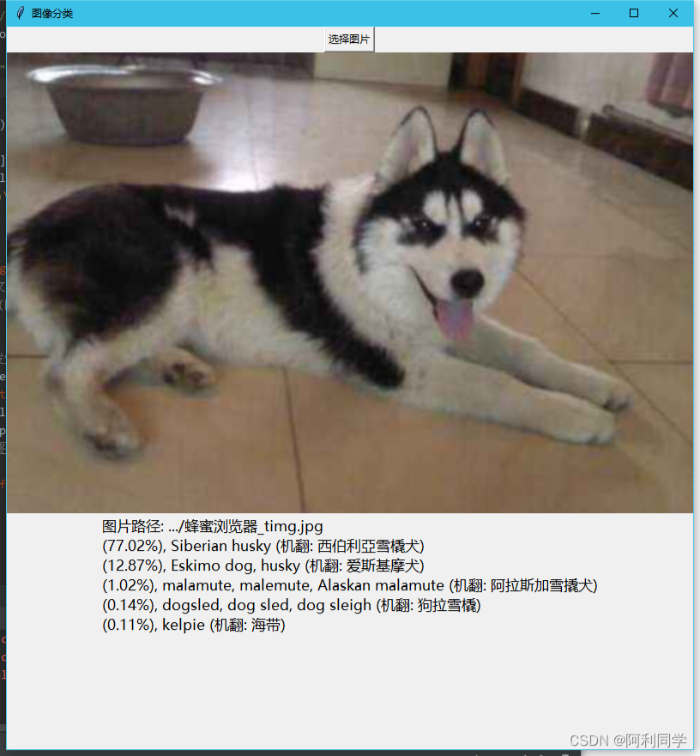
主要功能:利用tinker封装InceptionV3[论文]MOD进行图像分类的一个小Demo
环境:anaconda+Python3+tensorflow
IDE:pycharm + jupyter notebook
2.代码框架
需要的库模块:
-
os tarfile requests tensorflow numpy translate PIL
一共四个代码文件:
- get_Inception_model.py
方法模块,下载模型将模型保存到本地
def download_inception_model(): #下载模型将模型保存到本地
'......'
- nodelookup.py
类文件,主要功能将官方标签解码成可读文本
class NodeLookup(object):
def __init__(self):
self.node_lookup # 字典,id to string
'......'
@staticmethod
def _load(labels_path, uids_path): # 输入:node_id, 输出:id to string字典
'......'
return dict
def id_to_string(self, node_id): # 输入:node_id, 输出:可读字符串
'......'
return str
- tensorflow_predictor.py
类文件,主要功能实现图像预测
class TensorflowPredictor():
def __init__(self): # 加载模型,新建session,
'......'
def predict_image(self, image_path): #
'......'
return str
- gui.py
界面代码,面向用户
btn_sel # 选择图片按钮
img_label # 这是是显示预测图片的全局变量
res_label # 这是是显示预测文字的全局变量
def translator_prediction_result(pre_res):# 翻译模块 输入:英文字符串,输出:格式化中文字符串
'......'
return res
def selector_image(): # 选择图片按钮点击发生的事件
'......'
root.mainloop() # 进入消息循环
3.实现细节
3.1.下载模型
3.1.1.实现功能
下载模型将模型保存到本地
3.1.2.Inception文件简介
Inception_v3模型源码下载
Inception为Google开源的CNN模型,至今已经公开四个版本,每一个版本都是基于大型图像数据库ImageNet中的数据训练而成。因此我们可以直接利用Google的Inception模型来实现图像分类。本项目主要以Inception_v3模型为基础。分类一张图像可以在几秒内完成。
3.1.3.流程图

3.1.4.代码
# get_Inception_model.py
import tarfile
import requests
def download_inception_model():
# inception_v3模型下载
inception_pre_mod_url = 'http://download.tensorflow.org/models/image/imagenet/inception-2015-12-05.tgz'
# 模型存放地址
inception_pre_mod_dir = "inception_model"
if not os.path.exists(inception_pre_mod_dir):
os.makedirs(inception_pre_mod_dir)
# 获取文件名,以及文件路径
filename = inception_pre_mod_url.split('/')[-1]
filepath = os.path.join(inception_pre_mod_dir, filename)
# 下载模型
if not os.path.exists(filepath):
print('Downloading: ', filename)
r = requests.get(inception_pre_mod_url, stream=True)
with open(filepath, 'wb') as f:
for chunk in r.iter_content(chunk_size=1024):
if chunk: f.write(chunk)
print("Done: ", filename)
# 解压文件
tarfile.open(filepath, 'r:gz').extractall(inception_pre_mod_dir)
3.2.标签解码
3.2.1.实现功能
将标签编码和标签内容一一对应(解码)
3.2.2.文件
官方下载的文件夹下有两个文件
- imagenet_synset_to_human_label_map.txt
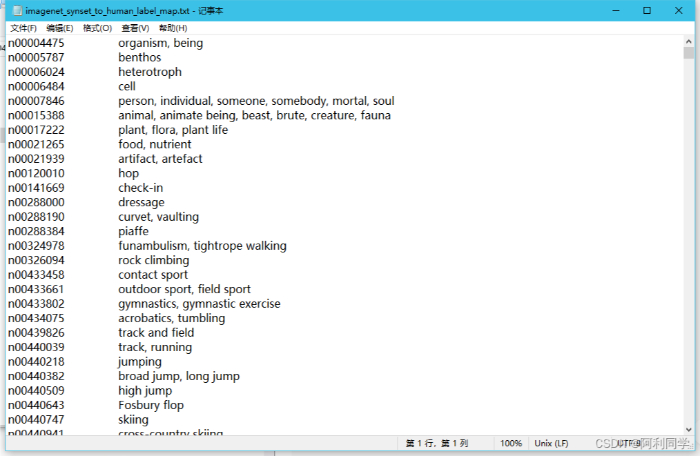
- imagenet_2012_challenge_label_map_proto.pbtx
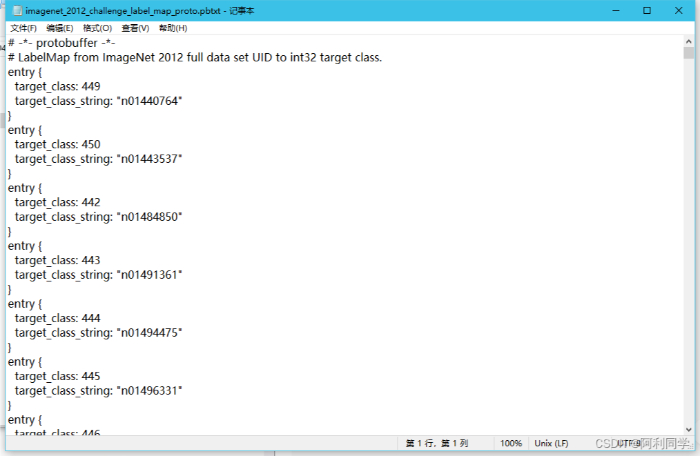
target_class对应着一个class_string,这里我们要做的任务就是将traget_class与human_string一一对应
3.2.3.代码
# nodelookup.py
import tensorflow.compat.v1 as tf
tf.disable_v2_behavior
class NodeLookup(object):
def __init__(self):
labels_path = 'inception_model/imagenet_2012_challenge_label_map_proto.pbtxt'
uids_path = 'inception_model/imagenet_synset_to_human_label_map.txt'
self.node_lookup = self.load(labels_path, uids_path)
@staticmethod
def _load(labels_path, uids_path):
uid_to_human = {}
for line in tf.gfile.GFile(uids_path).readlines():
items = line.strip('\n').split('\t')
uid_to_human[items[0]] = items[1]
node_id_to_uid = {}
for line in tf.gfile.GFile(labels_path).readlines():
if line.startswith(' target_class:'):
target_class = int(line.split(': ')[1])
if line.startswith(' target_class_string:'):
target_class_string = line.split(': ')[1]
node_id_to_uid[target_class] = target_class_string[1:-2]
node_id_to_name = {}
for key, val in node_id_to_uid.items():
name = uid_to_human[val]
node_id_to_name[key] = name
return node_id_to_name
def id_to_string(self, node_id):
if node_id not in self.node_lookup:
return ''
return self.node_lookup[node_id]
3.3.运行模型
3.3.1.流程图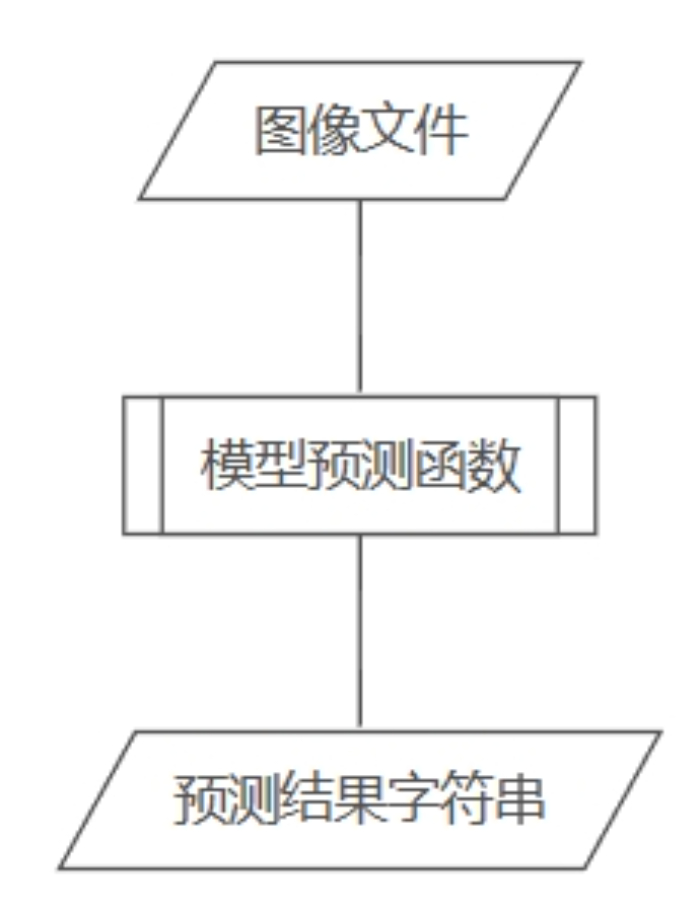
3.3.2.代码
import tensorflow.compat.v1 as tf
tf.disable_v2_behavior
import numpy as np
import nodelookup
class TensorflowPredictor():
def __init__(self):
self.sess = tf.Session()
with tf.gfile.FastGFile('./inception_model/classify_image_graph_def.pb', 'rb') as f:
graph_def = tf.GraphDef() # 定义一个计算图
graph_def.ParseFromString(f.read()) #
tf.import_graph_def(graph_def, name='')
self.softmax_tensor = self.sess.graph.get_tensor_by_name('softmax:0')
def predict_image(self, image_path):
# 载入图片
image_data = tf.gfile.FastGFile(image_path, 'rb').read()
predictions = self.sess.run(self.softmax_tensor, {'DecodeJpeg/contents:0': image_data}) # 图片格式是jpg格式
predictions = np.squeeze(predictions) # 把结果转为1维
# 打印图片路径及名称
res_str = ''
res_str += '图片路径: ' + image_path + '\n'
# 排序
top_k = predictions.argsort()[-5:][::-1]
node_lookup = nodelookup.NodeLookup()
for node_id in top_k:
# 获取分类名称
name_str = node_lookup.id_to_string(node_id)
# 获取该分类的置信度
score = predictions[node_id] * 100
res_str += '(%.2f' % (score) + '%), ' + name_str + '\n'
return res_str
3.4.GUI
3.4.1.运行图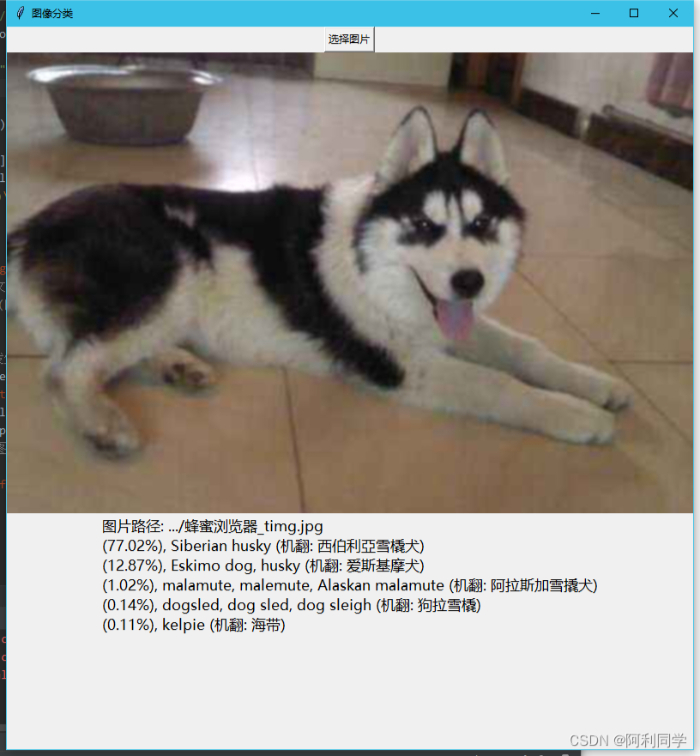
3.4.2.代码
import os
import tkinter
from tkinter import *
from tkinter import filedialog
from PIL import ImageTk
from translate import Translator
import get_Inception_model
from tensorflow_predictor import TensorflowPredictor
root = tkinter.Tk() # 生成root主窗口
root.title("图像分类") # 设置窗体标题
root.geometry("800x800") # 设置窗体大小
if not os.path.exists('./inception_model/classify_image_graph_def.pb'): # 如果没下载model,则下载model
get_Inception_model.download_inception_model() # 下载model
translator = Translator(to_lang="chinese") # 新建Translator对象
def translator_prediction_result(pre_res): # 翻译模块
res = pre_res.split("\n")[0] + '\n'
for line in pre_res.split("\n")[1:-1]:
s = translator.translate(line.split(',')[1])
res += line + " (机翻结果: " + s + ")\n"
return res # 返回翻译结果
img_label = Label(root, width='800', height='533') # 这是是显示预测图片的全局变量
res_label = Label(root) # 这是是显示预测文字的全局变量
pdt = TensorflowPredictor() # 新建预测类(自己写的)
def selector_image(): # 选择图片按钮点击发生的事件
img_path = filedialog.askopenfilename(initialdir='./images') # 弹窗选择图像文件返回图像地址
pre_res = pdt.predict_image(image_path=img_path) # 利用地址调用预测函数返回结果字符串
pre_res = translator_prediction_result(pre_res) # 机器翻译结果字符串
photo = ImageTk.PhotoImage(file=img_path)
img_label.config(imag=photo) # 更新图片
img_label.pack()
res_label.config(text=pre_res, justify=LEFT) # 更新文字
res_label.pack()
root.mainloop() # 进入消息循环
return
btn_sel = tkinter.Button(root, text='选择图片', command=selector_image) # 选择图片按钮
btn_sel.pack()
root.mainloop() # 进入消息循环(必需组件)
果字符串
photo = ImageTk.PhotoImage(file=img_path)
img_label.config(imag=photo) # 更新图片
img_label.pack()
res_label.config(text=pre_res, justify=LEFT) # 更新文字
res_label.pack()
root.mainloop() # 进入消息循环
return
btn_sel = tkinter.Button(root, text='选择图片', command=selector_image) # 选择图片按钮
btn_sel.pack()
root.mainloop() # 进入消息循环(必需组件)
总结
- Inception 是一种深度学习模型,主要用于图像分类任务。它是由 Google 团队于 2014 年开发的,并在 ImageNet
图像识别竞赛中取得了很好的成绩。 - Inception 模型的设计目标是在保持高准确率的同时,降低模型的计算复杂度。它采用了一种称为 Inception
模块的特殊结构,该模块可以同时应用多个不同大小的卷积核和池化操作,并将它们的输出拼接在一起。这样可以捕捉到不同尺度和层次的图像特征。 - Inception
模型的核心思想是使用多个并行的卷积操作来处理输入图像,并通过合并它们的输出来提取更丰富的特征表示。这种设计可以减少网络的参数数量,并增加模型的计算效率。 - Inception 模型的经典版本是 Inception V3,它包含多个 Inception
模块,每个模块都包含多个并行的卷积和池化操作。Inception V3 在 ImageNet
数据集上取得了很好的性能,同时也被广泛应用于其他图像分类任务。
除了 Inception V3,还有其他版本的 Inception 模型,如 Inception V1、Inception V2 等,每个版本在模型结构和性能上都有所不同。
总结起来,Inception 是一种用于图像分类任务的深度学习模型,通过使用多个并行的卷积操作和池化操作来提取图像特征。它在准确率和计算效率方面取得了良好的平衡,并被广泛应用于图像分类领域。


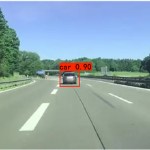



评论(0)
您还未登录,请登录后发表或查看评论